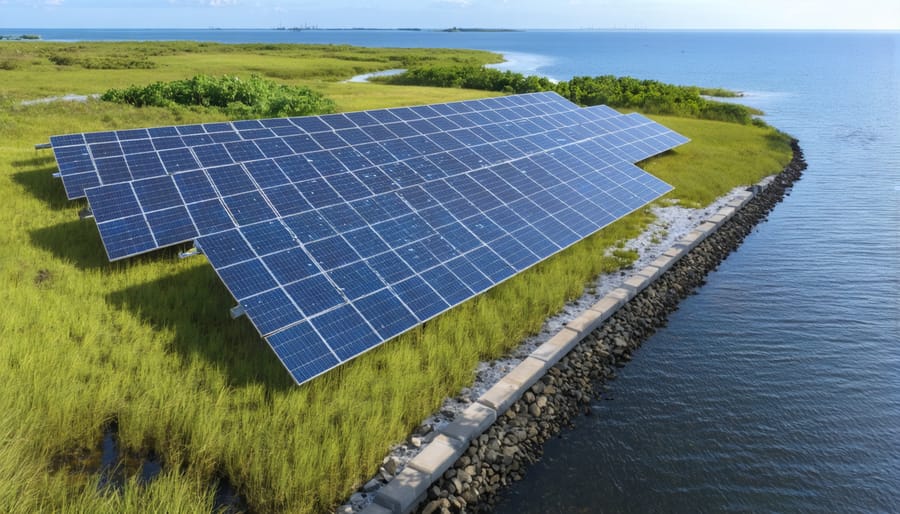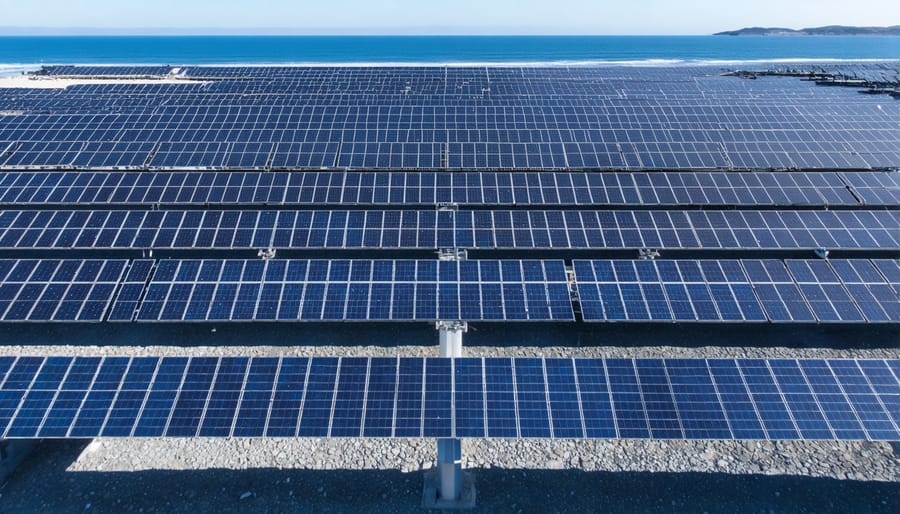How Coastal Resilience Safeguards Your Solar Investment Against Climate Change

Coastal resilience represents our communities’ vital capacity to withstand, adapt to, and rapidly recover from climate-related threats along our shorelines. As rising sea levels and increasingly severe storms challenge European coastal regions, this adaptive approach combines innovative engineering, nature-based solutions, and strategic planning to protect both infrastructure and ecosystems. Modern coastal resilience strategies integrate sustainable energy systems, robust flood defense mechanisms, and dynamic environmental management to create a powerful shield against climate vulnerabilities. For coastal communities, particularly those housing critical energy infrastructure, resilience isn’t just about survival—it’s about maintaining essential services, preserving economic stability, and ensuring long-term sustainability even under extreme conditions. This comprehensive approach to coastal protection has become increasingly crucial as European nations work to fortify their coastlines while advancing their clean energy goals and maintaining their maritime heritage.
Understanding Coastal Resilience: More Than Just Storm Protection

Key Components of Coastal Resilience
Coastal resilience strategies encompass several interconnected components that work together to protect coastal infrastructure, including vital energy resilience systems. The first key component is natural infrastructure protection, which includes preserving and restoring ecosystems like wetlands, mangroves, and dunes that act as natural buffers against coastal hazards.
Physical infrastructure adaptations form the second component, involving the reinforcement of existing structures and the implementation of flood protection measures. This includes elevated foundations, storm barriers, and resilient power distribution networks designed to withstand extreme weather events.
Community preparedness represents the third vital element, focusing on emergency response planning, early warning systems, and public awareness programs. This social aspect ensures that coastal communities can respond effectively to challenges while maintaining essential services.
The fourth component involves adaptive management strategies, which allow for flexible responses to changing conditions through continuous monitoring and assessment. This approach enables communities to adjust their resilience measures based on new data and emerging threats, ensuring long-term sustainability of coastal infrastructure and resources.
Environmental and Economic Benefits
Investing in coastal resilience yields significant dual benefits for both the environment and economy. By protecting natural coastal ecosystems like wetlands, mangroves, and dunes, these initiatives help maintain biodiversity while providing natural barriers against storms and flooding. These ecosystems also act as carbon sinks, contributing to climate change mitigation efforts.
From an economic perspective, coastal resilience measures deliver substantial returns on investment. Studies show that every euro invested in coastal protection can save up to six euros in potential damage costs. This includes protecting valuable coastal infrastructure, preserving tourism revenues, and maintaining property values in coastal areas. For coastal communities, these measures help safeguard local businesses, protect employment opportunities, and ensure the continuity of maritime industries.
The benefits extend to energy infrastructure security, with resilient coastal areas better protecting critical power installations and distribution networks. This enhanced protection translates into fewer service disruptions and reduced maintenance costs. Additionally, well-planned coastal resilience projects often create new opportunities for sustainable development, including eco-tourism and green energy initiatives, further strengthening local economies while preserving natural resources for future generations.

Climate Change Challenges for Coastal Energy Infrastructure
Coastal energy infrastructure faces unprecedented challenges from climate change, with rising sea levels and extreme weather events posing significant risks to critical installations. Along Europe’s coastlines, power plants, transmission systems, and renewable energy facilities must contend with increasingly frequent storm surges, coastal erosion, and flooding events that threaten operational continuity.
The vulnerability of these installations is particularly acute for traditional power stations, many of which require direct access to seawater for cooling systems. Rising sea temperatures can reduce cooling efficiency, while storm surges can damage intake structures and flood critical equipment. Offshore wind farms, though designed for marine environments, face intensified challenges from more frequent and severe storms, potentially affecting both their structural integrity and maintenance schedules.
Transmission infrastructure in coastal zones is especially susceptible to saltwater intrusion and corrosion, accelerated by rising groundwater levels and more frequent flooding. Substations and power distribution networks often require extensive protective measures to maintain reliability under these conditions. The combination of coastal erosion and subsidence can also compromise the stability of power line foundations and underground cables.
For emerging renewable energy installations along coastlines, adaptation strategies are becoming increasingly crucial. Solar farms in coastal areas must be designed to withstand salt spray and high winds, while wave energy converters need enhanced durability to survive more intense storm conditions. The interconnected nature of energy systems means that vulnerability in one component can cascade through the entire network, highlighting the need for comprehensive resilience planning.
These challenges necessitate innovative engineering solutions and robust emergency response protocols to ensure continuous power supply to coastal communities and industries.
Implementing Coastal Resilience in Energy Projects
Design and Engineering Solutions
Modern coastal resilience relies heavily on innovative engineering solutions that combine traditional infrastructure with cutting-edge technology. Protective structures like seawalls and breakwaters are being redesigned with advanced materials and adaptive features that respond to changing conditions. These solutions often incorporate nature-based elements, such as artificial reefs and restored wetlands, working in harmony with hard engineering measures.
Smart monitoring systems equipped with sensors and predictive analytics help anticipate and respond to coastal threats in real-time. These technologies are particularly crucial for maintaining climate-resilient power networks in coastal areas, ensuring continuous energy supply during extreme weather events.
Floating infrastructure and amphibious architecture represent another frontier in coastal resilience, allowing structures to adapt to changing water levels. Engineers are also developing innovative drainage systems and permeable surfaces that better manage flood waters while protecting critical infrastructure. These solutions often incorporate sustainable materials and green building practices, ensuring long-term durability while minimizing environmental impact.
Monitoring and Maintenance Strategies
Effective monitoring and maintenance strategies are essential components of coastal resilience management. Regular assessments of coastal infrastructure, natural barriers, and ecosystem health help identify potential vulnerabilities before they become critical issues. These assessments typically involve advanced monitoring techniques, including satellite imagery, drone surveys, and sensor networks that provide real-time data on wave patterns, erosion rates, and structural integrity.
Maintenance programs should follow a proactive approach, incorporating both scheduled interventions and adaptive management practices. This includes regular inspection of sea defences, beach nourishment projects, and vegetation management in coastal wetlands. European coastal communities have developed innovative maintenance protocols that combine traditional knowledge with modern technology, creating more efficient and sustainable protection systems.
Data-driven decision-making plays a crucial role in these strategies. By collecting and analyzing long-term environmental data, communities can better predict future challenges and adjust their maintenance schedules accordingly. This approach ensures optimal resource allocation while maintaining the effectiveness of coastal protection measures. Regular evaluation and updating of these strategies help communities adapt to changing climate conditions and evolving coastal dynamics.
European Leadership in Coastal Resilience
Europe stands at the forefront of coastal resilience innovation, implementing comprehensive strategies that protect both communities and critical infrastructure. The Netherlands, in particular, has emerged as a global leader with its Room for the River programme and the famous Delta Works project, demonstrating how engineered solutions can work in harmony with natural processes.
Countries like Denmark and Germany have pioneered the integration of resilient energy systems within coastal protection schemes, combining renewable energy infrastructure with flood defense mechanisms. The Danish Coastal Authority’s nature-based solutions have successfully protected vulnerable coastlines while preserving local ecosystems.
Notable success stories include Spain’s Barcelona coastal defense strategy, which combines traditional engineering with innovative urban planning to protect both historic architecture and modern developments. In Belgium, the Masterplan Kustveiligheid showcases how systematic approach to coastal protection can safeguard communities while supporting economic growth.
These initiatives demonstrate Europe’s commitment to developing sustainable coastal protection strategies that address multiple challenges simultaneously. By incorporating green infrastructure, protecting biodiversity, and ensuring economic viability, European coastal resilience projects serve as blueprints for global adaptation efforts.
The European Union’s investment in research and development through programs like Horizon Europe continues to drive innovation in coastal protection technologies, ensuring that member states remain at the cutting edge of resilience planning and implementation.

Coastal resilience represents a crucial investment in our future, combining innovative engineering solutions with nature-based approaches to protect our shorelines and critical infrastructure. As climate change continues to present increasing challenges, the implementation of resilient coastal strategies becomes more vital than ever. European communities are leading the way with comprehensive approaches that integrate renewable energy solutions, sustainable urban planning, and ecosystem preservation.
The success of coastal resilience initiatives depends on continued collaboration between governments, businesses, and local communities. Looking ahead, emerging technologies and improved modeling capabilities will enhance our ability to predict and respond to coastal threats. The integration of renewable energy infrastructure, particularly solar installations, with coastal protection measures demonstrates how resilience strategies can serve multiple purposes while supporting sustainability goals.
For European coastal regions, the future outlook is promising but requires sustained commitment to adaptation and innovation. By embracing comprehensive resilience strategies today, we can ensure the protection of our coastal communities, critical infrastructure, and natural resources for generations to come. The key lies in maintaining flexibility in our approaches while steadfastly pursuing long-term solutions that balance environmental, economic, and social needs.
Leave a Reply